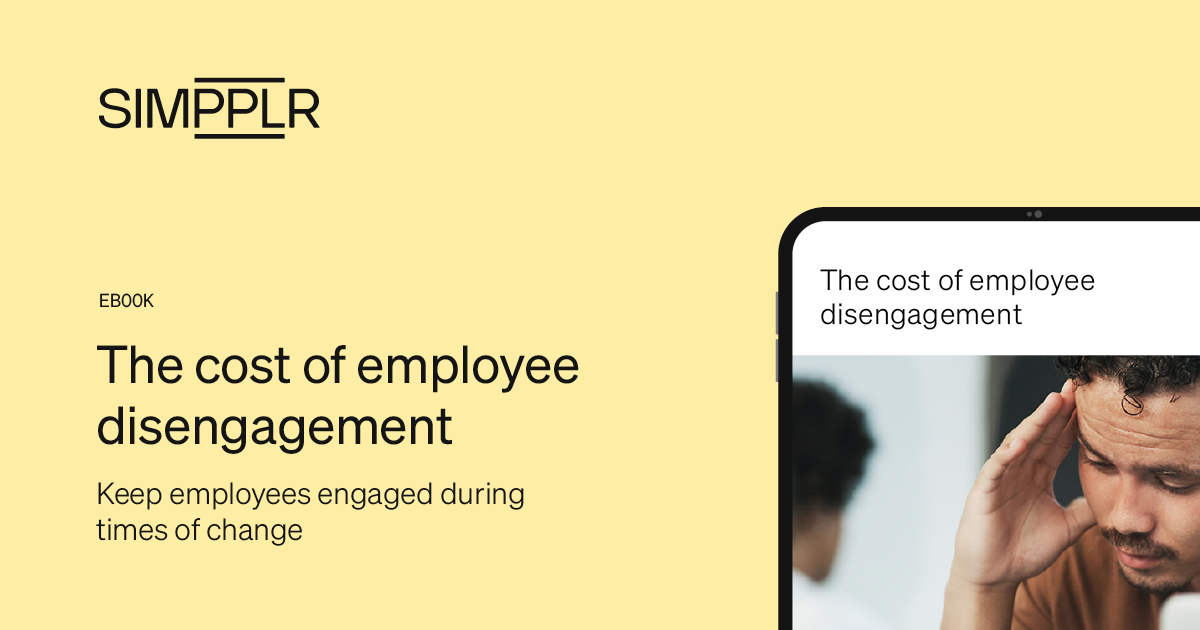The Great Resignation of 2021. And 2022. And 2023? If economic trends continue, that may well be the case. Attrition is increasing across the board and a lot of it has to do with employee disengagement.
Harvard economist Lawrence Katz calls the Great Resignation “a once-in-a-generation ‘take this job and shove it’ moment.” But it doesn’t have to be. Employee engagement can dramatically lower attrition rates in both high and low turnover industries.
But what exactly is employee disengagement? What does a disengaged employee look like? Or an engaged one? How does employee disengagement impact attrition? And what can you do to keep the engaged employees engaged and increase engagement for the others?
Characteristics of disengaged employees
To fully understand disengaged employees and how they can impact attrition, let’s first take a look at their opposite: the fully engaged employee.
Example of an engaged employee
Tara comes to work every day excited to do her job. Sure, some days she’s tired, but she takes initiative to start her work and chimes in during collaborations with her colleagues. If she needs to put in an extra hour or two to finish a project to the best of her ability, she’s happy to do so.
Tara is a fully engaged employee: she feels that her input is valued and her needs for work-life balance are respected.
Example of an actively disengaged employee
Now let’s take a look at Tara’s colleague Kevin. Kevin is deeply unhappy in his job. He acts out by distracting his coworkers and wasting time that could be spent on work. He sneers at his bosses and encourages his coworkers to do the same.
Unfortunately, Kevin is one of 20 million American employees who are actively disengaged. He dislikes the company that he works for and is trying to undermine it.
Example of a disengaged employee
There is a middle ground between the fully engaged Tara and the actively disengaged Kevin: Erik.
Erik likes his team members, but his engagement in the company has been falling. He does his work on time, but the drive and excitement he used to have are gone. Erik has stopped initiating collaborations because he feels that his contributions haven’t been recognized. He admires the company that he works for but fears he isn’t making a difference.
Erik is clearly disengaged. But how do we recognize a lack of engagement? What about Erik indicates that he is no longer engaged?
How to spot disengaged employees
Lack of motivation
This may manifest as work slowing down or even stopping altogether only to be completed in fits and starts. Employees like Erik often want to do the work but no longer see the point in completing their work to the best of their ability.
Increased absenteeism
Employees have a life outside of the office. Whether it’s taking care of kids, parents, or themselves, there will always be pieces of an employee’s life that come before work.
When an employee becomes disengaged, you may see an increase in absenteeism as they call out rather than try to negotiate their schedule. An engaged employee will discuss their scheduling needs with their manager or supervisor so as to disrupt the company as little as possible.
Decreased productivity
This manifests most obviously in sales but can be seen in all industries. Disengaged employees will take longer to finish projects or the results will be sub-par. These employees will take up more company time and resources to produce lower-quality products than their engaged coworkers.
Increased burnout
An employee who is constantly tired and slow to produce results is an excellent sign of employee burnout. Burnout occurs when an employee feels that they have worked hard and fast for too little reward. Consistent burnout leads to increased employee turnover.
Drop in customer experience
At the end of the day, unhappy customers will always affect your bottom line. Gallup found a direct correlation between customer loyalty and engagement in companies with higher employee engagement.
Root causes of employee disengagement
The tough truth is that an engaged workforce is not usually about the employees themselves. It’s about how they’re treated and how much they feel they can contribute, or can’t contribute.
Simply firing a disengaged employee is a short-sighted move that will only lead to more employee turnover. So, if it isn’t the people themselves, what causes employee disengagement?
There are three root causes:
- Lack of feedback. According to Gallup, employees who got feedback from their managers daily (rather than annually or less) were three times more likely to be engaged.
- No room for advancement. One of the biggest and most consistent reasons for employee disengagement, this issue leads to employees feeling that they are not valued.
- Confusion about responsibilities. A clearly defined role in the company gives employees confidence that their work can make a difference. Any confusion over who is responsible for a certain task is certain to lead to frustration and irritation.
Stages of employee disengagement
There is hope for your currently disengaged employees! Few employees actually start out as actively disengaged. However, even the best employee can lose interest if they don’t feel they’re being treated well.
Take the example of Erik from above: when he started his job, he was as engaged as Tara, but a lack of proper talent management left Erik feeling invisible and left behind.
The move from Tara to Erik can be observed through these three stages:
- Frustration. Erik finds himself irritated at the lack of feedback and employee recognition from his supervisors. How is he to know if he’s doing a good job if no one ever tells him?
- Questioning. Erik starts to wonder if his job actually makes any difference in the company. He wonders if business leaders really care about him or if he’s just a replaceable cog in a machine.
- Demotivation. Finally, Erik loses his initial fire and starts looking at his job as more of a paycheck than a worthwhile endeavor.
Everyone wants to feel that they bring something special to their role, but a company culture that values the role more than the person often leads to an employee who is not motivated at work.
Calculating the cost of employee attrition and disengagement
There’s no question that employee engagement affects a company’s bottom line: research shows that the cost of employee disengagement totaled $7.8 trillion in lost productivity globally.

The ROI benefits of employee engagement
The good news is that high engagement from employees leads to a lot of positives.
Companies with engaged employees do better in all kinds of metrics — productivity (up 18%), profitability (up 23%), customer loyalty (up 10%), and absenteeism (down 81%).
The impact of disengaged employees
We’ve seen that employee engagement can benefit a company, but how much does low employee engagement really cost?
Well, let’s break it down.
Disengaged employees lose all the ROI benefits listed above, PLUS they have negative effects of their own:
- Decreased retention means increased costs for training new employees.
- Decreased morale will affect everyone and lead to increased burnout and disengagement.
- Wasted time and company resources cost businesses approximately $500 billion every year.
- Gallup reports that disengaged employees even cause a rise in safety incidents (accidents).
The vicious cycle of disengagement and the costs of attrition
Why does losing employees cost so much? What’s the real cost of attrition?
The costs pile up quickly: first, your HR office must spend time and resources off-boarding the disengaged employee. Then they must recruit, onboard, and train a new employee. In the meantime, the current team is understaffed and scrambling to cover the sudden loss.
The costs won’t stop there. Disengaged employees affect levels of engagement for all members of the team, which may lead to more employees quitting.
Even one disengaged employee can start spreading the word that your business has a lousy work environment or workplace culture, which will make recruiting all that more difficult and time-consuming.
Gallup reports that in high-turnover organizations (those with more than 40% of annualized turnover), employee engagement can decrease employee attrition and turnover by as much as 18%. In low-turnover organizations, it’s more like 43%.
A certain amount of employee attrition is unavoidable, but it doesn’t have to be so costly. Companies with a positive employee experience enjoy higher employee engagement and well-being, increased employee retention, and dramatically decreased costs of attrition.
Improving employee engagement
If employee engagement can help your organization that much, and if disengaged employees can cost you that much, the real question is obvious: what can you do to improve employee engagement?
There are a lot of employee engagement strategies out there but they all come down to one core issue: communication.
Hybrid and remote work environments are here to stay and modern organizations must adapt to modern ways of communicating and engaging with their employees. Simpplr’s State of the Employee Experience 2022 found that 53% of employees on a hybrid in-person/remote schedule and 30% working primarily or fully remote. To foster employee engagement and a company culture of trust and teamwork, your company needs a fast and reliable network for communication with all employees.
Enter AI-driven intranet software that allows for both synchronous and asynchronous communication, so that every employee is always up to date and connected.
Are you interested in seeing how cutting-edge intranet solutions can simplify internal communications and maximize employee engagement? Request a demo of today.
GET SIMPPLR
Connect with Simpplr
Dont forget to share this blog!

















